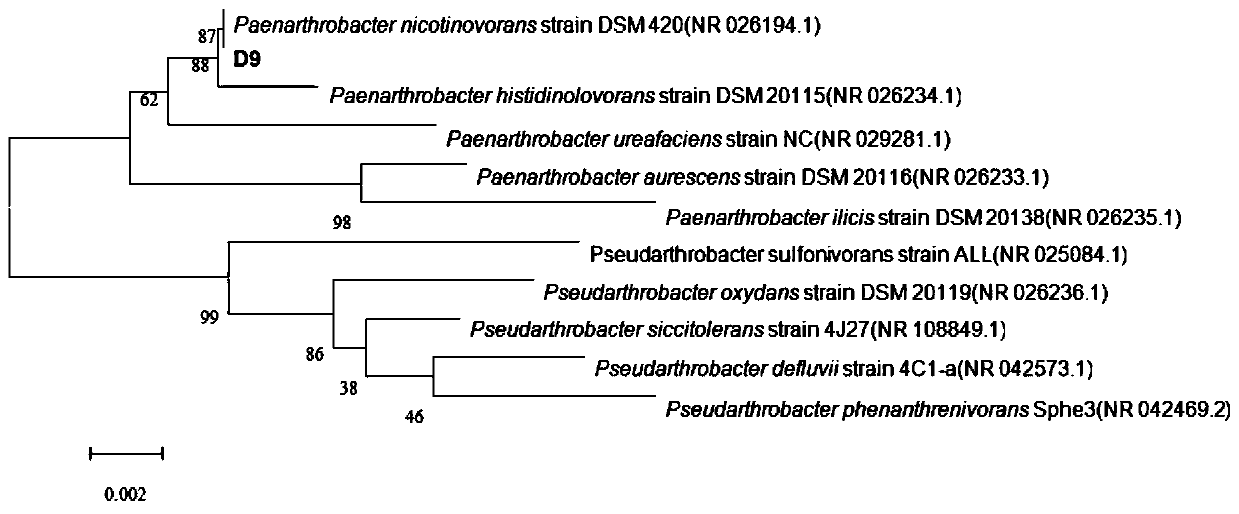Paenarthrobacter nicotinovorans and application thereof in preventing and treating diseases
A technology of Bacteroides nicotinica and Bacteroides nicotine, applied in the direction of application, bacteria, and microbial-based methods, can solve problems such as food safety, antibiotic microbial resistance, environmental pollution, etc., and achieve the effect of reducing the problem of pesticide abuse
- Summary
- Abstract
- Description
- Claims
- Application Information
AI Technical Summary
Problems solved by technology
Method used
Image
Examples
Embodiment 1
[0040] Example 1 The acquisition and identification of Bacteroides nicotinica strain D-9
[0041] 1. Isolation and screening of strain D-9
[0042] (1) Soil sample collection: Soil samples collected from the Arboretum of South China Agricultural University and the orchid greenhouse as microbial sources
[0043] Soil samples were collected from South China Agricultural University in Guangdong Province, bagged, stored, and taken back to the laboratory as a microbial source for strain isolation.
[0044] (2) Enrichment culture of bacterial strains: prepare basal salt (MSM) medium, and divide into 100 mL Erlenmeyer flasks, 50 mL for each bottle. Weigh 5g of soil sample, add soil sample (5g) and AHLs signal molecule (C6O3HSC, 100mmol, 12.5μL) into Erlenmeyer flask under sterile conditions, and place in 200rpm, 30℃ shaker for 7 days. After about a week, take out 1mL of the solution under sterile conditions, increase the concentration of AHLs signal molecules to twice the original ...
Embodiment 2
[0058] Antibiotic susceptibility analysis of embodiment 2 bacterial strain D-9
[0059] 1. In order to better study the biocontrol potential of the bacterial strain D-9 obtained in Example 1, we conducted in-depth research on the biological characteristics of the bacterial strain. The sensitivity of strain D-9 to different antibiotics was experimentally studied as follows:
[0060] Streak and activate the strain D-9 on a solid LB plate, pick a single colony and inoculate it into 1mL liquid LB, and culture it at 30°C and 200rpm until the bacterial liquid OD 600 The value is between 1.0 and 1.5; 13 concentration gradients are set for each antibiotic for detection, which are 5 μg / mL, 10 μg / mL, 20 μg / mL, 30 μg / mL, 40 μg / mL, 50 μg / mL, 100 μg / mL, 150 μg / mL , 200μg / mL, 250μg / mL, 300μg / mL, 350μg / mL, 400μg / mL, and a blank control. Six antibiotics including kanamycin (kan), ampicillin (amp), gentamicin (gen), streptomycin (str), carbenicillin (carb) and tetracycline (TC) were added to...
Embodiment 3
[0062] Example 3 Identification of Quenching Activity of Bacterial Strain D-9
[0063] 1. Strain cultivation and sample collection: Under the condition of 30°C, activate the strain D-2 on the LB solid plate. Pick a single colony and inoculate it into LB liquid medium, and culture overnight at 30°C and 200rpm to obtain a bacterial solution. Take a certain volume (V=1 / OD 600 ) was centrifuged at 4000rpm for 10min, the supernatant was discarded to obtain an OD 600 value bacteria. Will 1 OD 600 Value of the bacteria, inoculated into 1mL MSM inorganic salt medium with different AHLs as the sole carbon source. The reaction mixtures were placed in 2 mL centrifuge tubes, and the centrifuge tubes were incubated at 30° C. and 200 rpm for 24 h. After 24 hours, take 5 μL of the reaction mixture and spot it on the top of a 1 cm wide MM agar strip, and then spot the reporter strain (Agrobacterium tumefaciens NT1) bacteria solution below. Then place the agar strips with the reaction mi...
PUM
 Login to View More
Login to View More Abstract
Description
Claims
Application Information
 Login to View More
Login to View More - R&D
- Intellectual Property
- Life Sciences
- Materials
- Tech Scout
- Unparalleled Data Quality
- Higher Quality Content
- 60% Fewer Hallucinations
Browse by: Latest US Patents, China's latest patents, Technical Efficacy Thesaurus, Application Domain, Technology Topic, Popular Technical Reports.
© 2025 PatSnap. All rights reserved.Legal|Privacy policy|Modern Slavery Act Transparency Statement|Sitemap|About US| Contact US: help@patsnap.com



